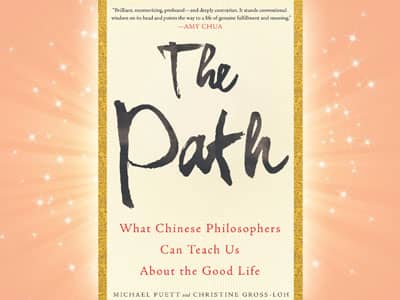
Many people are suspicious of rituals. They seem so at odds with cultural mores that emphasize authenticity, sincerity, and the true self. The following example shows how ritual can have a very powerful effect on human nature and human relationships.
In early China, people saw human beings as a mass of conflicting emotions, turbulent energies, and chaotic spirits that they worked to refine during their lives. But at the moment of death, a person’s most dangerous energies—his anger and resentment at passing away while his loved ones go on living—would be released and haunt the living. People believed that the world was filled with the spirits of the deceased, who looked jealously upon their survivors. Death would bring out the worst in the living as well: sadness, confusion, inexplicable anger.
To combat all of these negative, uncontrolled energies, people developed ritual acts, the most important of which was ancestral worship. The meat of a beast, most often a pig, would be placed in bronze ritual vessels and cooked over an open fire in front of the family at a temple. The family would call down the ghosts to feed on the rich smoke that rose up from the meat. By feeding the ghosts these offerings, the living hoped to bring them back into the family and persuade them to inhabit the role of benevolent ancestors hovering above.
After the ritual had ended, the ancestors eventually reverted to angry, haunting ghosts, and the rite would have to be repeated.
In the Analects, Confucius is asked about ancestor worship. He says that the ritual is absolutely necessary but that it makes no difference whether the spirits are participating or not: “We sacrifice to them,” he said, “as if they are there.” What matters is participating in the ritual fully.
But if ghosts aren’t even necessarily there, why do the ritual as if they are?
In life, the relationship between the deceased and the living might have been imperfect and fraught. A father was stern, unloving, and temperamental; his offspring were hostile and rebellious. If performed well, the ritual moves us from this troubled world of human relationships and creates a space in which ideal relationships can be forged. Within this space, it is as if the haunting ghosts are proper, beneficent ancestors to the living. The living now behave as if they were proper descendants of the ancestors. The angers, jealousies, and resentments that had existed between the living and the dead are being transformed into a vastly better relationship.
For Confucius, the ritual was essential because of what it did for the people performing it. To ask whether these ritual acts actually affected the deceased or not missed the point entirely. Family members needed to make the sacrifices because acting as if the ancestors were there brought about change within themselves.
The ritual also changed the feelings of the living toward one another. A death always engenders changes in relationships among those left behind. A long-dormant childhood rivalry between two siblings flares up again; a wayward son suddenly becomes the nominal head of the household, stirring unrest among the others. Within the ritual, however, all play their new familial roles as if there were no discord.
Of course, the ritual always ends. Family members walk out of the ritual space, and the moment they do, they are in the messy world again. Siblings squabble, cousins rebel, the father and son are still at odds with each other.
This is why families returned to the ritual repeatedly. Gradually, by doing the rituals again and again and re-creating these healthier connections, the improved relationships among the family members would begin to manifest more in daily life.
The ritual does not tell anyone how to behave in the real world. The perfectly ordered world inside the ritual could never replace the flawed world of real-life relationships. It works because each participant plays a role other than the one he inhabits normally. That “break” with reality is the key for allowing the participants to begin to work on their relationships.
Sacrificing beasts and placating spirits may seem distant from our twenty-first-century lives, but the value of the rituals remains. We too are haunted by ghosts: the irritating relative we never get along with; the grudge we can’t seem to shake off; the past we can’t forget.
We tend to fall into patterned, habitual responses. They may be social conventions and customs we follow unthinkingly, like our greetings or the way we hold a door open for someone. They may be routines that we don’t even notice, such as the whine we slip into when we’re talking to a sibling on the phone, or a tendency to become quiet when distressed instead of expressing our needs clearly. But we do these things all the time. Some patterns are good, and some are less so. If we were always “true” to ourselves and behaved accordingly, we would be stuck in old behaviors, never forgiving, and limiting our potential to transform.
But we already know how to break these patterns.
When we visit a friend’s family, for example, as outsiders we notice their routines: their Sunday morning pancake breakfast, the way they hug one another to say good morning. These rituals stand out because they are new to us. When we observe or participate in them, we do so with a consciousness that we don’t bring to our own lives.
When we travel, breaking from our everyday routine can allow us to develop new sides of ourselves. And when we return, we feel the lingering effects of those changes.
Why, then, don’t we do this all the time? Perhaps it is because deliberately constructing ritual moments in our “real” lives feels contrived.
But as-if moments can lead to tremendous movement.
Think of playing a game of hide-and-seek with a four-year-old. When you crouch with your foot sticking out of a closet door so that she can find you easily, when she laughs with glee upon discovering you, and when you enthusiastically repeat the game with her again and again, you are not just engaging in lighthearted play. The game is an as-if ritual. It allows a shift in roles: the child gets to play at being a powerful person who bested an adult by finding him. The adult gets to play at being a bumbling person so inept that he can’t even find a good hiding place.
This breaks their usual pattern. The child gets to experience a feeling of competence that she will remember even after the game is over. The adult, usually an infallible being (at least in the eyes of a child), has now played at being fallible and vulnerable. The role reversal helps him to develop more complex, nuanced sides of himself that he, too, can take with him into other situations: vulnerability, connection, levity, and the ability not to cling to power too tightly.
The key for the players is to be conscious that they are pretending; that together they have entered an alternate reality in which they imagine different sides of themselves. If they can do this, then not only will these experiences help cultivate a mutually more joyful and respectful relationship, but also these accumulated moments will influence the sort of person each becomes over time. These repeated rituals will develop aspects of each of them that eventually enhance other relationships in both of their lives.

